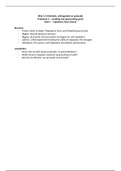Samenvatting
Cognitive Behavior Therapy Basic and Beyond Summary Chapter 3
- Instelling
- Universiteit Utrecht (UU)
This is the summary of the third chapter of the book "COGNITIVE BEHAVIOR THERAPY: BASIC AND BEYOND" by Judith S. Beck (Second Edition 17. August 2011). I focused on summarizing the most important aspects of the chapter. Whenever I thought it might be worth to read a passage directly from the book I...
[Meer zien]














